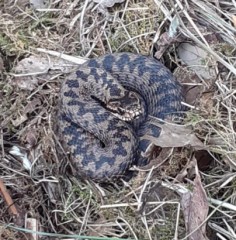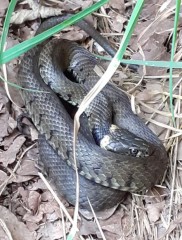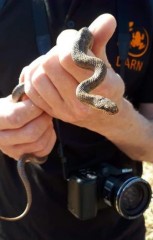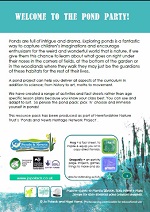About us
About Us
DARN is a network of people in Dorset interested in our native reptiles and amphibians. Its purpose is to promote the conservation, recording and appreciation of native amphibians and reptiles in the county of Dorset. DARN serves as a means of communication between volunteers, professionals and the general public. DARN members pay an annual fee of £6 and then when suitably trained they can take part in our widespread reptile surveys. These can be viewed once reptile surveyor status has been achieved. DARN is also running the SliC project - Slow-worms in Churchyards. We have rare reptile survey sites on FE and MOD land and we are continually adding new transects as we expand our activities across the county. DARN also monitors non-native species to try to assess any impact on our native species.
Dorset has 12 of the UK's 13 native amphibian and reptile species, and a handful of non-native species. Its internationally-important heathlands are famous as national strongholds for the rare reptiles - Sand Lizard and Smooth Snake - and southwest England's only populations of our second-rarest amphibian, the Natterjack Toad. With such an important wildlife heritage in Dorset, several wildlife NGOs have their headquarters in the county, including the Amphibian and Reptile Conservation Trust (ARC). Together with the various statutory bodies and local authorities, this means Dorset has many wildlife professionals. DARN aims to form a link between all these people, and to nurture an appreciation among the general public for our herpetofaunal friends.
Sheila Dyason is Chair of DARN. DARN Dispatches is a newsletter that is produced at least twice a year, telling you of news, items of interest, and projects to get involved in. Dorset is home to some of the most important reptile and amphibian populations in the country, with a high concentration of protected sites, conservation activities and research projects. There are endless opportunities for helping out by volunteering, and there are already many volunteers in the county who give their time towards projects helping to conserve our herpetofauna, and raise awareness.
The History of the DARN Group
DARN was set up as a surveying and recording group on 30/01/2020. Previously it had been an email and facebook group.
The founding members were Sheila Dyason as Chair, Catherine Dyason as Secretary, Pete Gillatt as Treasurer.
The Group started with rare reptile sites which Sheila had arranged with Forestry England to survey as part of HIWARG – the Hampshire Group. Some of them had been set up and monitored by David Tamarind who sadly died recently. There were not any widespread species surveys for members to get involved with so Sheila set up the SliC Project – Slow-worms in Churchyards - as a way to get members involved in surveying.
As of July 2021 DARN has 8 widespread reptile transects set up in north Dorset and three more rare reptile transects including one on MOD land. DARN is working with land owners and managers such as Forestry England, Butterfly Conservation, the Dorset Wildlife Trust, the MOD, church communities and private land owners.
News
News
DARN Dispatches 9
DARN Dispatches 9 October 2021
A big THANK YOU to Tina, Warren, Cathy, Paul, Pete G, Pete W and friends at HIWARG for your continued support with surveys, habitat management and advice.
I know I say this every time but DARN does continue to expand its activities with more surveyors, more transects, more sightings. So, thank you to everyone for continuing to make DARN so successful!
Habitat management season has just started and we have completed two tasks in Ringwood Forest with more planned here and in Hurn Forest and on other sites.
Pond surveys will be a new feature for next year and we will also be looking for non-native herp species in the county.
The SliC surveys – Slow-worms in Churchyards – are also continuing to expand in Dorset and there are also now 6 sites in the New Forest. Thank you to the New Forest Park Authority for their generous grant to fund these.
David, our foreign correspondent in Greece, continues to send us wonderful photos of sightings from his back garden and beyond. Thanks David. Keep them coming!
We held a face-to-face Committee Meeting last month and we will be having a zoom Committee Meeting next month. Thanks to Pete Gillatt for organising the zoom session.
Warren and Tina have been busy setting up more transects across Dorset with rare reptiles being found on many of them. Cathy and I have also set up transects on a wildlife friendly farm, a SANG, a Common, and we are planning visual surveys along disused railway tracks.
With Halloween approaching I was interested to read that ‘Eye of newt’ referred not to an amphibian but to a plant! Mustard seed. Shakespeare’s “Macbeth” describes a concoction that consists of:
“Eye of newt (mustard seed) and toe of frog (buttercup leaves),
Wool of bat (moss) and tongue of dog (hounds tooth),
Adder’s fork (violet), and blind-worm’s sting (knotweed),
Lizard’s leg (ivy), and howlet’s wing (garlic)
For a charm of powerful trouble,
Like a hell-broth boil and bubble.”
As usual, if you have any herp records (not plants), historic ones are fine as well especially as I have just found out how to add them to ARGWEB when there isn’t a grid reference, send them to me or add them to Casual Sightings on the DARN website: www.groups.arguk.org/darn or on Record Pool: www.recordpool.org.uk or email the details to: sheiladyason2007@yahoo.co.uk
Also, if you are interested in becoming a DARN reptile surveyor, email me and we will arrange for ARGWEB and field survey training if it is needed and then you will be given access to our widespread transect sites.
I look forward to hearing from you
Keep safe!
Sheila Dyason
Chair of DARN
Conservation opportunities for everyone!
DARN Dispatches 8
I am sure that many of you would have known David Tamarind as he had been herping in Dorset for many decades. He sadly passed away recently. He was collecting data on rare reptiles right up to the end even though mobility problems were slowing him down. He will be sadly missed.
DARN continues to expand its activities with more surveyors, more transects, more sightings. So, thank you to everyone for continuing to make DARN so successful!
The SliC surveys – Slow-worms in Churchyards – are also continuing to expand and we soon hope to have sites across Dorset. Slow-worms have been found in all the Dorset burial ground sites that we are surveying and Warren Port and Tina-Louise Gower have also found a Grass Snake and a Great Crested Newt at one churchyard which was particularly exciting. If you know of other churchyards that might like to participate then please let me know.
David, our foreign correspondent in Greece, continues to send us wonderful photos of sightings from his back garden and beyond. Thanks David. Keep them coming!
A zoom Committee meeting was held recently and plans for the future discussed.
Warren has reminded us that it was International Snake Day yesterday and he shared some photos of Dorset snakes to celebrate.



Thanks Warren!
As usual, if you have any records, historic ones are fine as well, add them to Casual Sightings on the DARN website: www.groups.arguk.org/darn or on Record Pool: www.recordpool.org.uk or email the details to: sheiladyason2007@yahoo.co.uk
Also, if you are interested in becoming a DARN reptile surveyor, email me and we will arrange for ARGWEB and field survey training if it is needed and then you will be given access to our widespread transect sites and you can help us to record reptiles in Dorset.
I look forward to hearing from you
Keep safe!
Sheila Dyason
Chair of DARN
Conservation opportunities for everyone!
DARN Dispatches 7
DARN Dispatches 7
Well, we’re in the middle of spring but it has been pretty nippy recently.
DARN continues to expand in all directions with more surveyors, more transects, more sightings. So, thank you to everyone who is helping to make DARN so successful!
HIWARG has been a good friendly neighbour and helped us with some ARGWEB and field survey training.
We have new transects in North Dorset with more to follow and one on an MOD site which is particularly exciting.
The SliC surveys – Slow-worms in Churchyards – are also continuing to expand with sites in Dorset, Hants, Berks and soon in Wilts as well. So far Slow-worms have been found in more than 25% of the sites and in Dorset in more than 70% of the churchyards. If you know of other churchyards that might like to participate then please let me know.
David, our foreign correspondent in Greece, continues to send us wonderful photos of sightings from his back garden and beyond. Thanks David. Keep them coming!
A BBQ is being planned for DARN surveyors for the end of the season. More details next time.
As you probably know we have registered Dorset Amphibian and Reptile Network (DARN) with #easyfundraising, which means over 4,000 shops and sites will now donate to us for FREE every time we use #easyfundraising to shop with them.
These donations will help SO MUCH, so please sign up to support us – it is completely FREE and does not take long.
You shop. Dorset Amphibian and Reptile Network (DARN) gets money. For free.
Help us when you shop with 4,300 shops & sites. Join now.
So far more than £30 has been raised through EasyFundRaising which is brilliant! Thanks everyone – that will fund another reptile transect.
As usual, if you have any records, historic ones are fine as well, add them to Casual Sightings on the DARN website: www.groups.arguk.org/darn or on Record Pool: www.recordpool.org.uk or email the details to: sheiladyason2007@yahoo.co.uk
I look forward to hearing from you
And I eagerly anticipate even more great things for DARN in 2021
Keep safe!
Sheila Dyason
Chair of DARN
Conservation opportunities for everyone!
DARN Dispatches 6
DARN Dispatches 6
Well, spring is nearly here and there have been some fantastic Adder and Common Lizard sightings already.
Don’t forget to add your sightings to ARGWEB or Record Pool.
Frog spawn can be added as well. There were 70+ clumps at Ringwood Forest which was more than twice as much as last year. Five clumps in my little garden ponds and Palmate Newts.
Toad patrols were difficult to carry out this year unless there was one locally.
Unfortunately, we only managed one habitat management session but we still made an impact and thanks to Pete Gillatt (HIWARG) there is now a reptile transect set up in Hurn Forest as well.
The SliC Project – Slow-worms In Churchyards - now has 23 transects set up and 12 waiting to be set up so let’s hope for a bumper crop of Slow-worms.
The Zoom Herp Workers Meeting was a great success and there was even a talk on Slow-worms by Allyson Hawkins (HIWARG). The ARG UK AGM was the following week and the local ARGS had the opportunity to report on their Group’s activities. So yes, I gave an update on the SliC project and some craft activities I have been developing for a ‘Slow-worms are Sensational’ pack. I had permission to develop this from the ‘Adders are Amazing’ pack.
The other exciting new is that I have just been appointed as an Administrator for ARG UK on a part-time temporary contract to help with projects etc.
We’ve registered Dorset Amphibian and Reptile Network (DARN) with #easyfundraising, which means over 4,000 shops and sites will now donate to us for FREE every time we use #easyfundraising to shop with them.
These donations will help SO MUCH, so please sign up to support us – it’s completely FREE and doesn’t take long.
You shop. Dorset Amphibian and Reptile Network (DARN) gets money. For free.
Help us when you shop with 4,300 shops & sites. Join now.
Hopefully in a few weeks, as the lockdown gradually eases, we will be able to move around the county a bit more, set up some more transects and get surveying.
As usual, if you have any records, historic ones are fine as well, add them to Casual Sightings on the DARN website: www.groups.arguk.org/darn or on Record Pool: www.recordpool.org.uk or email the details to: sheiladyason2007@yahoo.co.uk
I look forward to hearing from you
And I eagerly anticipate great things for DARN in 2021
Keep safe!
Sheila Dyason
Chair of DARN
Conservation opportunities for everyone!
DARN Dispatches 5
DARN Dispatches 5

A big thank you to everyone who has helped to makes DARN’s first year so successful despite the ongoing Coronavirus issues. Also, a special thank you to our friends at HIWARG (Hampshire and Isle of Wight Amphibian and Reptile Group) who continue to be so supportive of all we are trying to achieve.
And what a lot we have achieved!!!
*We have 10 transects set up on 3 major rare reptile sites
*We have 3 transects set up to survey for widespread reptile species and more are being
planned
*We have collected Frog, Toad and Newt data from numerous ponds across the county
*The SliC (Slow-worms in Churchyards) Project now has transects set up in 20 churchyards
and burial grounds and we have permission to set up 10 more.
*Our membership continues to steadily increase
*Habitat management has been carried out to remove Pine and Birch from heather banks and
verges
There are more habitat management sessions planned with the next one is at Hurn Forest on Sunday 3rd January 2021. The details are on the Events page. So if you would like to come along and help to improve the habitat for reptiles you will find a warm welcome. Just make sure that your DARN membership is up to date and for insurance purposes, that you have completed the Volunteer Worker’s Agreement (VWA). The session will run from 10 – 1 but you can leave at any time. To join us just click ‘going’ on the Events page. It will be a socially distanced event in accordance with the latest Government guidelines and it will be a joint event with HIWARG members.
If you know of any areas that would benefit from some extra habitat management then let me know. Also, if you know of other churchyards, burial grounds or other areas where a reptile transect could be set up let me know.
So, if you have some spare time, there are plenty of opportunities to join in and help conserve Dorset’s amphibians and reptiles; meet other volunteers and see some stunning scenery and wildlife.
If you have any records, historic ones are fine as well, add them to Casual Sightings on the DARN website: www.groups.arguk.org/darn or on Record Pool: www.recordpool.org.uk or email the details to: sheiladyason2007@yahoo.co.uk
If you have any ideas for activities or for developing the Group just email me.
I look forward to hearing from you
And I eagerly anticipate great things for 2021
Keep safe!
Sheila Dyason
Chair of DARN
Conservation opportunities for everyone!
Join up or Log in
Join up or Log in
Info & ID guides
Info & ID guides
Herp Identification - downloadable colour charts
Amphibian Identification - downloadable colour cards
Reptile Identification - downloadable colour cards
Newt Eggs & Larvae - downloadable colour cards
![]() Its_a_small_newt_but_which_one_1.pdf
Its_a_small_newt_but_which_one_1.pdf
Dogs & Adders - downloadable advice sheet.
Improving Herp habitat
Creating Garden Ponds - downloadable booklet
ARGWEB Tutorials
![]() ARGWEB Pond Survey Recording Guide
ARGWEB Pond Survey Recording Guide
![]() ARGWEB Reptile Transect Survey Guide
ARGWEB Reptile Transect Survey Guide
Types of Sightings typically recorded on ARGWEB
How to record a transect survey data
Herp diseases - recognise & report
Snake Fungal Disease
Toad fly (Lucilia bufonivora)
Amphibian Chytridiomycosis
Ranavirus Disease
Reptile Slough Genebank - collection & submission of found sloughs
Other
Useful glossary of terms often used within the herpetological field. (Credit due - unknown)
Kids stuff - Educational items for the young ones
Pond pack 
Photo gallery
Photo Gallery
Upcoming Events
Upcoming events will be listed here.
Latest News
- DARN Dispatches 18
03/06/2025 7:43 pm - DARN Dispatches 17
12/12/2024 1:47 pm - DARN Dispatches 16
18/08/2024 7:19 pm - Happy 4th Birthday to the DARN Group
30/01/2024 7:50 pm - DARN Dispatches 15
15/01/2024 7:41 pm
© Dorset Amphibian and Reptile Network (DARN)
Website hits: 66873
View All | Find out how to get a mini-website for your ARG
© ARG UK Local Groups mini-websites 2025
Wind powered websites by Aye-aye Design.
